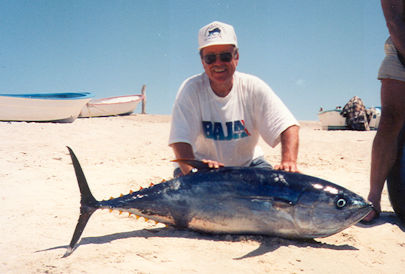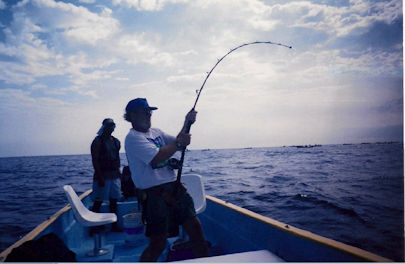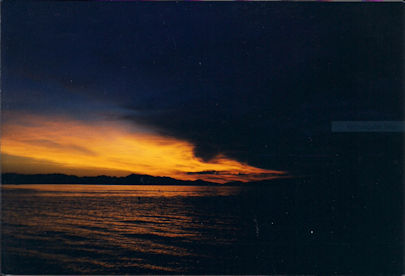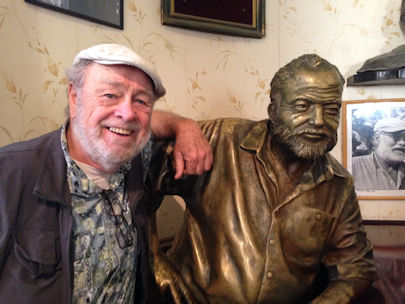 |  |
By Greg Niemann

The tuna hit the bait hard, snapping me out of my reverie. It was 1998 and we were fishing out of Baja’s La Paz area. Leaving Punta Arena, we were north of Cerralvo Island at a seamount called El Bajo. My fishing buddy Don Lund, the skipper Jesus and I were drifting cut squid from our 23-foot panga, occasionally pulling the lines in to maneuver to another spot.
Most of the other pangas that day were commercial fishermen hand lining for bottom species. A half dozen boats also carried sportsfishers like us and we’d seen several tuna hookups nearby. So we drifted and waited, basking in the hot, humid July sun.
The tuna hit so hard I didn’t even have to set the hook. The rod doubled over and my 50-pound line began singing off the reel. I tightened the drag a little lest I get spooled too easily, while Jesus and Don pulled in their lines.
Jesus even helped with the 65 horsepower outboard motor, maneuvering in the same direction as the fish. I cranked the reel, gaining a little line. The big fish pulled the hard-earned line right back out.
It was a stand-off and we’d just have to battle it out. Tuna don’t seem to tire like marlin or sailfish, who after a few dramatic leaps in the air seem easier to boat. Pound for pound, tuna are the fightingest fish I’ve ever caught.
Don’s 30-pound yellowfin tuna the day before took him a half hour to bring in. A few years previous, my 100-pound yellowfin tuna with my same equipment took two hours and ten minutes.
Tuna go straight down, deep. They circle. They fight. They don’t jump, and they don’t give up. I was in for a battle.
The heavy humid air along with the physical exertion had me sweating rivulets. My arms started getting sore.
Black cloud on the horizon
Looking about, I noticed a heavy black cloud above the horizon out over the gulf. The rest of the sky was bright blue with intermittent ivory clouds.
I battled the fish, gaining, then losing, then gaining again for about 40 minutes. That black cloud was coming closer, and as it did the wind picked up. We all noticed the abrupt change in weather. White caps roiling the water were moving closer to us.

I’d heard of chubascos, those often-regionalized, abrupt violent hurricane-like storms that strike almost without warning, but had never experienced their fury. I’d been surprised by wind and a quick, choppy sea before, but never a full-blown chubasco – until this day!
Several of the boats took off to escape the approaching weather. Jesus was concerned. He agreed we too should leave as soon as we brought the fish on board. I fought standing up, without a shoulder harness, just a leather rod butt belt for another 10 minutes. The storm got closer and the remaining boats were hastily beating retreats.
I handed the rod to the younger, stronger 29-year-old skipper, hoping he could bring the fish in before we had to leave. Jesus knew time was of the essence better than either of us, and he tried to muscle the fish in.
The rod doubled over to where I was sure it would snap. For 15 minutes Jesus fought and fought, barely gaining back some of the line. The storm was now almost fully upon us and we all knew a decision had to be made. The last boat had just left and we knew we had to go.
We looked seriously at each other, saying nothing, but our eyes spoke volumes. I knew what I had to do. With Jesus holding the line taut, I grabbed my knife and cut the line, releasing my huge tuna to fight another angler, another day.
Jesus quickly grabbed the tiller and made for Cerralvo, about three miles away.
The sea got violent
The storm hit suddenly and the Sea of Cortez got violent. Not only were white caps all around us, but the ocean swells were huge and powerful.
The rain came in sheets, drenching us completely. With the rain the wind intensified. Don’s cap blew off and sailed into the mean sky. The fish tank hatch blew off. I couldn’t see. The salt water stung my eyes. My throat got sore from swallowing so much salt water which splashed over us with the wind and rain.
Visibility became minimal for all of us. Occasionally out of the dark cloud I could see the outline of the island which seemed so far away. Then it would disappear. I don’t know how Jesus kept the panga in the right direction.

Wind-whipped waves came at us unrelentingly. The bow of our fragile panga would ride up one wave only to be slammed into the trough, exacerbating pain in my long-suffering back. We held on for our lives, and sometimes the jolts were so sudden our hands would break loose of their hold on the gunwale and slam back down adding pain to our fingers and joints.
Sometimes the waves were so close the bow would slam into the next wave, digging right into it with a scary and painful jolt.
Some wave sets were huge, six, eight feet and more, and if Jesus did not approach them just right, we’d roll from side to side, coming close to capsizing.
I looked into the roiling water, waves furiously moving from east to west. The western lee of the island was straight ahead. A strong swimmer might make it, but not in a storm like this. He would be swept far to the west, where the Baja landfall was many miles away. Plus, as was too often the case in Baja pangas, we had no life jackets so survival would have been iffy at best. If we tipped over I concluded that it would be best to try to hang onto the boat.
A half hour of terror
It took about a half hour of sheer terror before we reached the lee of the island and safety. We looked at each other and could visibly see the tension slip away. Jesus breathed easier and it was only then when I realized this 12-year fishing veteran had also been very unnerved.
"Señor," he said, once we displayed tentative smiles and tried to relax, "Thank you for cutting your fish. I think five minutes more we would have been in big trouble. We left just in time."
We stayed close to the shoreline down the 12 miles of Cerralvo Island. The sun came out and it seemed peaceful. But ahead we still had about a five-mile storm-whipped channel to cross to get to Punta Arena and the mainland.
We headed into the chop and the waves were large and formidable. I looked back and Jesus made a circle of his forefinger and thumb, meaning, "It’s okay; it’s tough, but nothing I can’t handle." And he handled it expertly, riding the troughs when he could, and turning directly into the larger waves. On real big sets, he even throttled down giving us a smoother ride up and down the roller coaster waves.

A crowd gathered on shore
A small crowd had gathered on shore. It appears most gringos had fished south of the island and did not experience the full onslaught of the chubasco. Someone said that one of the fishermen on the last boat in before us had got out and kissed the ground.
As we told our story to other gringo fishermen, Jesus was relaying our experience to fellow pangeros. About the fish, I heard him tell them, "No se, pero fue muy grande! Mas que 50 kilos," I don’t know how big it was, but it was real big, at least 50 kilos (110 pounds).
In the spring of 2015 I visited Cuba and went to the village where Ernest Hemingway was inspired to write "The Old Man and the Sea." As I watched a few weathered old Cuban fishermen come in, I recollected my 1998 experience in Baja, and thought about when I lost my fish. While Hemingway’s "Old Man" lost his fish to a mighty predator, I had lost mine to a mighty storm.
During that storm, I learned renewed respect for the strength of the yellowfin tuna, as well as greater admiration for the daring pangeros like Jesus. Most of all, I looked at the fickle Sea of Cortez through more weathered eyes. I will never again be casual about fishing there.
About Greg
Greg Niemann, a long-time Baja writer, is the author of Baja Fever, Baja Legends, Palm Springs Legends, Las Vegas Legends, and Big Brown: The Untold Story of UPS. Visit www.gregniemann.com.

Fabulous service. The video to get to the San Ysidro/Tijuana SENTRI lines was perfect and peace of...

Quick, Easy, and Effortless! Thanks Baja Bound !!

Super-easy and instant. Very happy with initial purchase.